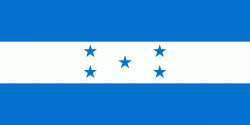Francisco Morazán Department (Departamento de Francisco Morazán)
Francisco Morazán, FMO is one of the departments of Honduras.
It is located in the central part of the nation. The departmental capital is Tegucigalpa, which is also Honduras's national capital. Until 1943 it was known as Tegucigalpa department. It was named after national hero Francisco Morazán.
The department is very mountainous, with rugged ranges covered in pine forests; which are rocky and mostly clay. Valleys, like those of Guaimaca, Talanga, and Amarateca, are interspersed among the ranges. Many of the high mountain peaks house cloud forests, like La Tigra National park or Cerro Uyuca. The extreme southeastern portion of the department has a Pacific dry forest environment, while the northern portion contains the Montaña de la Flor, home to the Jicaque people.
Francisco Morazán department covers a total surface area of 7946 km² and, in 2005, had an estimated population of 1,680,700 people.
The coat-of-arms and department flag of Francisco Morazán Department are the same as its capital, Tegucigalpa.
* 1) Alubarén
* 2) Cedros
* 3) Curarén
* 4) Distrito Central (cap. Tegucigalpa)
* 5) El Porvenir
It is located in the central part of the nation. The departmental capital is Tegucigalpa, which is also Honduras's national capital. Until 1943 it was known as Tegucigalpa department. It was named after national hero Francisco Morazán.
The department is very mountainous, with rugged ranges covered in pine forests; which are rocky and mostly clay. Valleys, like those of Guaimaca, Talanga, and Amarateca, are interspersed among the ranges. Many of the high mountain peaks house cloud forests, like La Tigra National park or Cerro Uyuca. The extreme southeastern portion of the department has a Pacific dry forest environment, while the northern portion contains the Montaña de la Flor, home to the Jicaque people.
Francisco Morazán department covers a total surface area of 7946 km² and, in 2005, had an estimated population of 1,680,700 people.
The coat-of-arms and department flag of Francisco Morazán Department are the same as its capital, Tegucigalpa.
* 1) Alubarén
* 2) Cedros
* 3) Curarén
* 4) Distrito Central (cap. Tegucigalpa)
* 5) El Porvenir
Map - Francisco Morazán Department (Departamento de Francisco Morazán)
Map
Country - Honduras
 |
 |
| Flag of Honduras | |
Honduras was home to several important Mesoamerican cultures, most notably the Maya, before the Spanish colonization in the sixteenth century. The Spanish introduced Catholicism and the now predominant Spanish language, along with numerous customs that have blended with the indigenous culture. Honduras became independent in 1821 and has since been a republic, although it has consistently endured much social strife and political instability, and remains one of the poorest countries in the Western Hemisphere. In 1960, the northern part of what was the Mosquito Coast was transferred from Nicaragua to Honduras by the International Court of Justice.
Currency / Language
| ISO | Currency | Symbol | Significant figures |
|---|---|---|---|
| HNL | Honduran lempira | L | 2 |
| ISO | Language |
|---|---|
| ES | Spanish language |
















